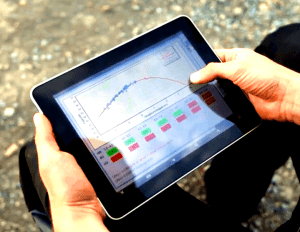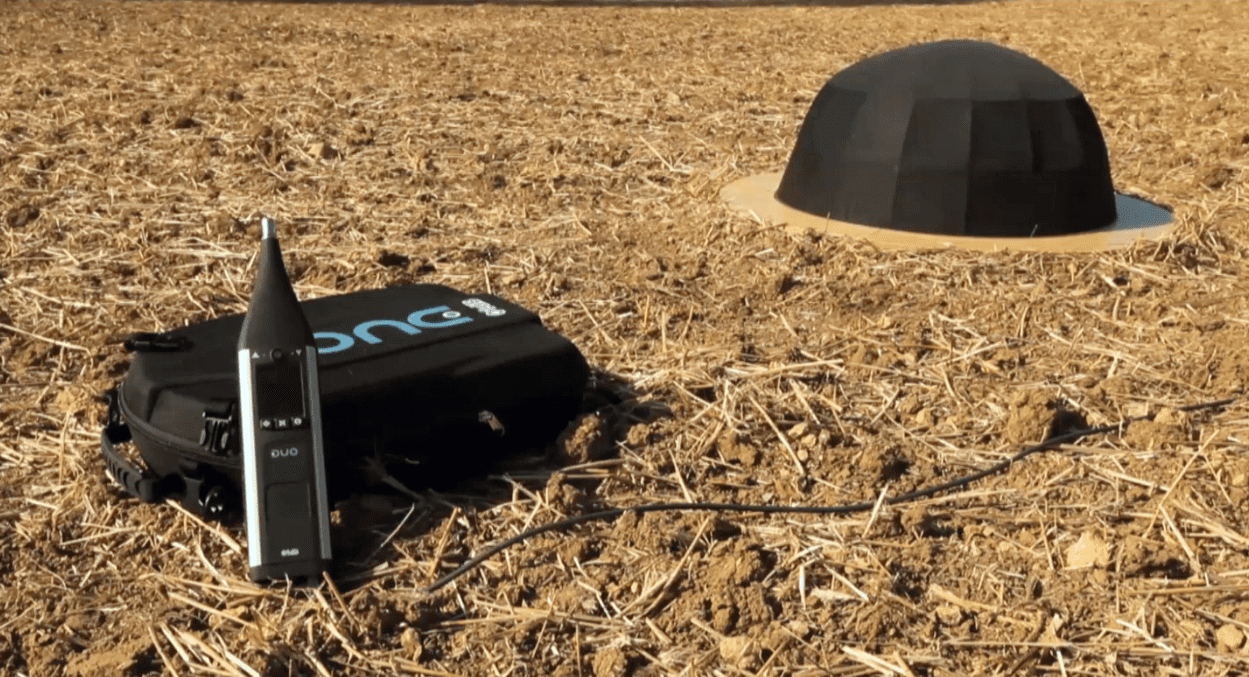New Regulatory Demands for Acoustic Assessments of Wind Turbine Noise

Wind turbine acoustical data collection challenges
These standards demand that three different sets of data, (sound pressure, wind speed & direction, and turbine electrical power) all be captured in-field, simultaneously. The protocol also requires that these outputs be tracked and ‘binned’ in wind speed intervals of 0.5 m/s and then analyzed so that an average value of sound power output can be obtained in each bin and evaluated later for compliance.
 What makes this protocol especially challenging for acoustical consultants is that different kinds of data must be gathered synchronistically under variable field conditions, using different kinds of equipment at different field positions: acoustical data is gathered using a sound level monitor that must be placed at a specified distance downwind of a turbine; meteorological data must be acquired using an anemometer placed upwind 10m above the ground; operational data must be collected from the wind turbine itself.
What makes this protocol especially challenging for acoustical consultants is that different kinds of data must be gathered synchronistically under variable field conditions, using different kinds of equipment at different field positions: acoustical data is gathered using a sound level monitor that must be placed at a specified distance downwind of a turbine; meteorological data must be acquired using an anemometer placed upwind 10m above the ground; operational data must be collected from the wind turbine itself.
Gathering and merging the results of these disparate data sources can not only be time consuming, but can also cause delays since analysis time is required to determine if sufficient data has been obtained. When inadequate data is collected, field measurements must be retaken, potentially leading to project delays, extra costs and feelings of frustration by all impacted stakeholders.
Parallel to the growing adoption of wind farms world-wide has come greater understanding and scrutiny of noise and health concerns around this renewable energy source.Because of the sensitive nature of these issues, and the greater scrutiny of noise and health concerns around this renewable energy source, acquiring precise acoustical data for analysis as quickly as possible has never been more in demand or more critical for all concerned.
“Unfortunately standards, practices and technologies around the world are playing catch-up to the rapidly evolving realities on the ground,” notes Brian Howe, President of HGC, during discussions on these issues. Brian is an internationally recognized authority on wind turbine noise.
“The real acoustical consulting challenge we face today is finding efficient ways to more accurately capture, quantify and address the fundamentally subjective characteristics of wind turbine noise. As leaders in this area, we feel it’s our responsibility and obligation to be on top of, and pioneering next-generation best practices and technologies well ahead of their general adoption by the industry”.
CSA-61400-11 /IEC 61400-11 measurement protocols
 To that end, HGC has recently been one of the first in North America to acquire a commercial state-of-the-art measurement and analysis system which streamlines assessments of CAN/CSA-61400-11 and IEC 61400-11) protocols. This European engineered hardware/software solution by WÖlfel of Germany, allows the three different data streams to be consolidated, viewed and verified simultaneously for integrity in real-time via a wireless network.
To that end, HGC has recently been one of the first in North America to acquire a commercial state-of-the-art measurement and analysis system which streamlines assessments of CAN/CSA-61400-11 and IEC 61400-11) protocols. This European engineered hardware/software solution by WÖlfel of Germany, allows the three different data streams to be consolidated, viewed and verified simultaneously for integrity in real-time via a wireless network.
The results? Uncompromising and unrivaled speed, accuracy and customer satisfaction.
Low frequency and infrasonic noise measurements
Beyond the standards’ protocol requirements, there are yet a number of acoustic characteristics of wind turbine sound which have not traditionally been considered significant to overall sound levels, but are today nonetheless perceived to influence the perception of sound and the potential for annoyance.
Some of these characteristics have been the subject of much debate and discussion, in particular with regards to their potential effects on residents living in the vicinity of wind developments. These include enhanced amplitude modulation of sound (blade swish); tones, like those that can arise from mechanical components such as gearboxes; low frequency sound; as well as infrasound.
Low frequency and infrasonic noise can be most effectively measured and assessed when separated from overall wind turbine sound levels. Most jurisdictions around the world however, do not yet have environmental policies which offer comprehensive protocols and criteria for the measurement and assessment of low frequency emissions.
Unfortunately standards and practices around the world are playing catch-up to the rapidly evolving realities on the ground.To further complicate matters, unlike most industrial or commercial noise sources, the sound emissions from wind turbines typically occur during wind conditions that can generate significant levels of background noise. Conventional acoustic instrumentation, normally used for the measurement of industrial noise sources, are prone, in wind development applications, to capturing erroneous acoustical data due to wind blowing over the microphone, particularly during high winds. Consequently, in order to accurately measure sound levels restricted to wind turbine activity alone, specialized techniques and equipment have become necessary.
Recently, the Ontario Ministry of the Environment, released a report researched and prepared by HGC entitled “Low Frequency Noise and Infrasound Associated with Wind Turbine Generation Systems, A Literature Review”.In 2007, HGC authored “Wind Turbines and Sound: Review and Best Practice Guidelines” for the Canadian Wind Energy Association (CanWEA). This guide is used extensively by leading industry developers and operators.
For some acoustic measurements, the Ontario Ministry of the Environment (as specified in CAN/CSA-61400-11 and IEC 61400-11)) now requires a microphone to be installed on a reflective surface at ground level with a large windscreen dome over a smaller conventional windscreen acting as both protection and as a way to limit turbulence at the
microphone face in order to reduce false low frequency readings caused by high winds’ actions.
 Until recently, no widely available commercial windscreen existed as defined by the standards. As a result, HGC initially researched and developed its own in-house solutions. But recently Bruel & Kjær, a world-leading manufacturer of acoustic test and measurement systems introduced an out-of-the-box engineered solution that is performance calibrated and traceable to international standards. Subsequently, HGC acquired a pair of these windscreens upon their release in North America.
Until recently, no widely available commercial windscreen existed as defined by the standards. As a result, HGC initially researched and developed its own in-house solutions. But recently Bruel & Kjær, a world-leading manufacturer of acoustic test and measurement systems introduced an out-of-the-box engineered solution that is performance calibrated and traceable to international standards. Subsequently, HGC acquired a pair of these windscreens upon their release in North America.
“Although these windscreens ensure our field measurement techniques comply with the new MOE audit requirements, it is important to point out that the methods called for in CAN/CSA-61400-11 and IEC 61400-11)were not developed specifically for wind turbine low frequency and infrasound measurements,” notes Mr. Howe. “In fact, there is no established protocol for the measurement of infrasound from wind turbines.”
Acoustical research and development
To that end, HGC continues to research and develop alternative techniques for low frequency and infrasound measurements which can more effectively filter out the influence of wind gusts on a field microphone’s acoustical readings.
One sub-surface method that the company is currently field-testing shows significant promise. It involves the placement of a microphone in a below ground “chamber” and includes a dual windscreen arrangement — a primary windscreen around the microphone and a secondary foam layer shield mounted over the chamber itself.
